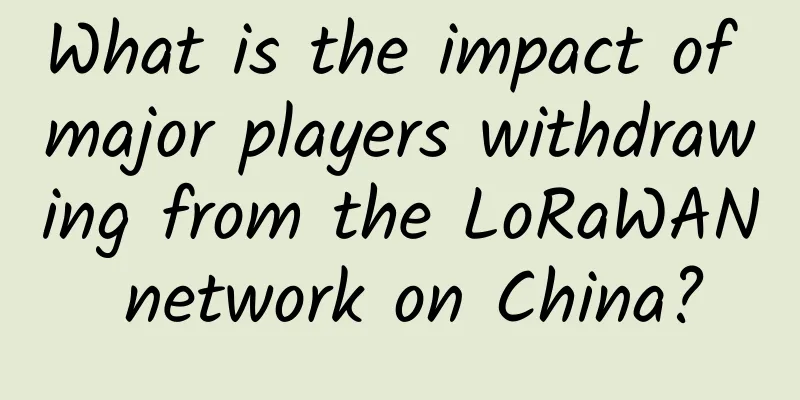What is the impact of major players withdrawing from the LoRaWAN network on China?

|
According to foreign media enterpriseiotinsights, Bouygues Telecom, one of the four major telecom operators in France, announced plans to shut down its LoRaWAN network in France in 2024, while launching a new IoT business sales plan and migrating existing IoT accounts to its cellular-based NB-IoT and LTE-M networks. Bouygues Telecom is one of the earliest large telecom operators to support LoRaWAN, and its IoT subsidiary Objenious is a long-term member of the LoRa Alliance. Now Bouygues Telecom plans to shut down its LoRaWAN network, probably because it encountered the same difficulties as Orange, SKT and other operators who also deployed LoRaWAN networks in the early days - the operating business did not improve much. Major players exit LoRaWAN networkBouygues Telecom wrote in a statement that cellular IoT technology is catching up, and mobile operators have become more mature in pricing and roaming services, which has led us to make the decision to exit the non-cellular LoRaWAN network. In view of the rapid development of cellular networks, Objenious will re-accelerate its positioning and strive to become the first IoT manufacturer in France that can provide both NB-IoT and LTE-M networks. At the same time, Bouygues Telecom said that the access rights to the LoRaWAN network, roaming transactions, management platform and various analytical tools provided by the Objenious Starer product will expire on September 1, 2022, and the relevant products will no longer be sold in the future. Bouygues will provide customers with network migration services and replace them with cellular IoT solutions. Bouygues Telecom added that by the end of 2022 (2023), cellular NB-IoT and LTE-M IoT will account for more than half of its LPWAN device connections, and by the end of 2024 it will completely switch off its LoRaWAN network. As one of the earliest large telecom operators to support LoRaWAN, Bouygues Telecom has provided conditions for the faster and more widespread application of LoRaWAN around the world due to its early efforts. However, it is precisely because of this that Bouygues Telecom's decision to withdraw from the LoRaWAN network has also caused a lot of doubts about non-cellular networks in the industry. This reminds people of the end of January, when Sigfox, another non-cellular technology also born in France, fell into the dilemma of being sold off. Its parent company, the world-renowned Internet of Things company Sigfox, filed for bankruptcy protection with the French judicial authorities. The Toulouse Commercial Court of France took over Sigfox and its subsidiary Sigfox France SAS (Sigfox's operator in France) and began looking for new buyers. The demise of Sigfox is mainly related to its own operations and strategies. Sigfox’s innovative model in many aspects has injected new impetus into the field of the Internet of Things, especially breaking the situation where only telecom operators provide long-distance connections, and launching operator-level network services focused on the Internet of Things. However, it is precisely this innovation of Sigfox that has laid the hidden danger for its subsequent financial difficulties. A startup company can deploy its network to dozens of countries and regions through a large amount of financing in the early stage of its business. However, network construction and operation is an asset-heavy business after all, requiring huge investments, and the number of connections needs to be increased quickly to dilute the initial investment. In addition, in recent years, the development of the low-power wide area network market has been far below expectations. In addition, other technologies such as NB-IoT and LoRa have matured and occupied most of the market share. Sigfox has only achieved 20 million connections worldwide, and the revenue it can bring is very meager. Therefore, it is not surprising that Sigfox eventually went bankrupt. Looking at Bouygues Telecom's withdrawal from the operation of the LoRaWAN network, it is actually facing the common difficulty faced by most IoT operators - the difficulty in balancing costs and revenues. Operators deploy LoRaWAN as a nationwide public network to provide services, which itself requires high network construction and maintenance costs. At the same time, from the perspective of revenue, the past few years have been the beginning of the low-power wide area network, and there is no good business model to support the network to gain revenue. For such a project that requires long-term investment and "regardless" of returns, even giant operators must be cautious in their judgment. In addition, from the perspective of social benefits, Bouygues Telecom's shift to cellular NB-IoT and LTE-M may be more in line with the trend of 5G network construction. Bouygues has repeatedly mentioned in the news that it will build an operator with full coverage of cellular Internet of Things technology in the future. Especially in the 5G era, Bouygues, which has been slow in NB-IoT and LTE-M, needs to "act decisively" and "take drastic measures." Therefore, judging from the fact that Bouygues Telecom withdrew from the operation of the LoRaWAN network, it seems that it has indirectly confirmed that the public network based on LoRaWAN may not be the best choice for operators. However, this will not affect the development of LoRa, because the flexible deployment model of dedicated or private networks may be the best destination for LoRa. Bouygues Telecom's exit from LoRaWAN network has limited impactThe LoRa or LoRaWAN market will not be disrupted so easily, and its impact on domestic and foreign markets is limited, especially for the development of the domestic LoRa industry. For China, due to the restrictions of radio frequency regulatory policies, the possibility of deploying public networks using the LoRaWAN specification is itself unlikely. On the contrary, flexible privatization deployment or private network mode has injected greater vitality into the development of LoRa. Many manufacturers have explored mature business models in providing private and private networks in small areas such as factories and communities, and this model is in line with the requirements of current domestic regulations. Many domestic manufacturers have innovated on the basis of the LoRaWAN protocol with the help of LoRa modulation technology, including point-to-point communication protocol innovation in campus and smart home scenarios, and low-latency communication protocol innovation in industrial and energy scenarios, forming the extension and derivative of the LoRaWAN protocol, effectively solving many pain points in actual implementation scenarios, and promoting the continued growth of the LoRa ecosystem in China. The fact that domestic shipments of LoRa-related devices and equipment are still growing rapidly shows that China is still its largest market. Internationally, on November 29, 2021, the International Telecommunication Union (ITU) standardization department officially approved the "ITU-T Y.4480 Low power protocol for wide area wireless networks" recommendation (standard) initiated by the LoRa Alliance. Most of the content of this standard is based on the mature link layer protocol of LoRaWAN, and is technically equivalent to the LoRaWAN link layer standard. After being established and approved by the ITU standardization department, LoRaWAN has been recognized by the most authoritative international organization in the global ICT industry, further enhancing its international influence. As the main promoter of LoRa and LoRaWAN, Huang Xudong, vice president of sales for Semtech China, recently briefed the think tank on the progress of LoRa's global deployment: as of December 2021, more than 2.7 million LoRa-based gateways and more than 225 million LoRa-based terminal nodes have been deployed worldwide. The deployment of LoRa or LoRaWAN covers 171 countries and regions. In three years, the number of LoRaWAN operators has tripled to 163. At the same time, as a global IoT industry alliance for LPWAN applications, the LoRa Alliance has developed more than 400 members, including heavyweight software companies and satellite communication service providers such as Microsoft, Cellnex, EchoStar, Eutelsat, as well as well-known Chinese manufacturers such as Tencent and Alibaba. "Technology drives production, and the market verifies implementation." LoRa has gone from obscurity to becoming the industry's de facto standard and then formally recognized by the ITU, which is enough to show that its position as a mainstream IoT connection technology is unshakable. Therefore, Bouygues Telecom's withdrawal from the LoRaWAN network operation is actually a result of the market's spontaneous choice, and it is also a manifestation of the industry's continuous exploration of better and more suitable business models for LoRa and LoRaWAN. |
<<: HTTP Cache Protocol Practice
>>: Intelligent wireless coverage solutions in complex industrial environments
Recommend
In the data era, Ruishu Information helps operators build a security line of defense for application data with five tips
On December 10, 2021, the "2021 (11th) Telec...
ARP protocol in TCP/IP protocol suite
[[355450]] 1. Introduction to ARP protocol In the...
Storage requirements for reliable 5G gateways in industrial systems
Manufacturing and production are being revolution...
Technical discussion on obtaining client IP address in C#
In web development, getting the client's IP a...
Deep Love News: The Data Center of the Future
Currently, most new data centers are operating at...
Daily Bug Troubleshooting-All Connections Suddenly Closed
Preface The daily bug troubleshooting series is a...
Commercial CDN returns to its original intention: focus on details and maximize distribution efficiency
On October 20, Live Video Stackcon 2017 was held ...
How should a small LAN with less than 10 or 100 people be established?
What is a local area network? The so-called local...
Sharktech: $129/month high-defense server, 2*E5-2678V3/64GB/1TB NVMe/1Gbps unlimited traffic
Sharktech is a shark computer room (or SK compute...
Qualcomm, Ericsson and OPPO achieve Europe's first commercial 5G SA network
According to foreign media reports, OPPO, Ericsso...
What does the operator's first-half performance reflect about the second half of the year?
With the release of the operating data of the thr...
With the three major operators working together to promote 5G messaging, how far is it from success?
On April 8, China Mobile, China Telecom, and Chin...
HostYun: AMD5950X Australian VPS monthly payment starts from 31 yuan
HostYun is a long-established VPS hosting company...
How does Shaanxi Government Affairs Cloud, which is required to be online throughout the entire process, take the lead in setting the trend?
From the Qin Emperor and Han Emperor to Emperor W...
DediPath New Year's Day promotion: 1Gbps unlimited traffic VPS from $9 per year, dedicated server from $39/month, multiple data centers in Los Angeles and other places
DediPath has launched another promotion during th...

![[6.18] LOCVPS 20% off, top up 100 get 10 yuan / top up 5000 get 618 yuan, 4G memory package starts from 52 yuan/month](/upload/images/67cabe8b75a0f.webp)



![[11.11] Maxthon consoles are 32% off, top up 611 yuan and get 111 yuan for free](/upload/images/67cac02720a21.webp)



